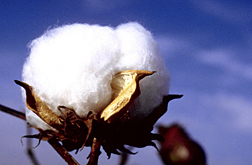|
Read the
magazine
story to find out more. |
|

ARS research is helping protect cotton plants from
Fusarium wilt. Photo courtesy of National Cotton Council of
America.
|
|

|
New Pima Cottons Fight Fusarium
Fungus
By Marcia
Wood February 25, 2008
Some of your favorite clothes, towels and sheets might be made with
cotton, America's best-selling fabric. But cotton plants won't produce top
yields of the fluffy white bolls if they're clobbered by a microbe known as FOV
race 4, short for Fusarium oxysporum f.sp. vasinfectum.
Now, studies by Agricultural Research Service (ARS) scientist
Mauricio
Ulloa and cooperators may lead to new ways to combat the disease.
The Fusarium fungus can clog a plant's vascular system, or
"plumbing," according to Ulloa. He's a geneticist at the ARS
Western
Integrated Cropping Systems Research Unit in Shafter, Calif.
Already, Ulloa, ARS colleague
Richard
Percy at College Station, Texas, and Michael Davis and Robert Hutmacher of
the University of California have
developed four new kinds of Fusarium-resistant pima cotton plants. Pima
cotton makes premium fabrics for clothing and home.
The scientists will offer these parent pimas, known as SJ-07P-FR01
through -FR04, to cotton breeders and researchers this year. The plants rank as
the first publicly owned pimas that have good resistance to race 4;
good-to-superior fiber length, which is important to fabric quality; and
moderate yields, according to Ulloa.
Now the scientists are testing hundreds of upland cotton plants.
Upland cotton offers excellent, less expensive fibers. And, in related studies,
Ulloa and co-investigators are delving more deeply into cotton's genetic
makeup.
The intent? To find markers—genetic material that indicates the
presence of genes of potential interest. The scientists have already identified
a significant number of markers that may prove to be indicators of
Fusarium resistance.
Read more
about this research in the February 2008 issue of Agricultural Research
magazine.
ARS is the U.S. Department of
Agriculture's chief scientific research agency.